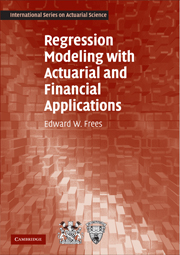Book contents
- Frontmatter
- Contents
- Preface
- 1 Regression and the Normal Distribution
- Part I Linear Regression
- Part II Topics in Time Series
- 7 Modeling Trends
- 8 Autocorrelations and Autoregressive Models
- 9 Forecasting and Time Series Models
- 10 Longitudinal and Panel Data Models
- Part III Topics in Nonlinear Regression
- Part IV Actuarial Applications
- Brief Answers to Selected Exercises
- Appendix 1 Basic Statistical Inference
- Appendix 2 Matrix Algebra
- Appendix 3 Probability Tables
- Index
10 - Longitudinal and Panel Data Models
Published online by Cambridge University Press: 05 June 2012
- Frontmatter
- Contents
- Preface
- 1 Regression and the Normal Distribution
- Part I Linear Regression
- Part II Topics in Time Series
- 7 Modeling Trends
- 8 Autocorrelations and Autoregressive Models
- 9 Forecasting and Time Series Models
- 10 Longitudinal and Panel Data Models
- Part III Topics in Nonlinear Regression
- Part IV Actuarial Applications
- Brief Answers to Selected Exercises
- Appendix 1 Basic Statistical Inference
- Appendix 2 Matrix Algebra
- Appendix 3 Probability Tables
- Index
Summary
Chapter Preview. Longitudinal data, also known as panel data, are composed of a cross-section of subjects that we observe repeatedly over time. Longitudinal data enable us to study cross-sectional and dynamic patterns simultaneously; this chapter describes several techniques for visualizing longitudinal data. Two types of models are introduced, fixed and random effects models. This chapter shows how to estimate fixed effects models using categorical explanatory variables. Estimation for random effects models is deferred to a later chapter; this chapter describes when and how to use these models.
What Are Longitudinal and Panel Data?
In Chapters 1–6, we studied cross-sectional regression techniques that enabled us to predict a dependent variable y using explanatory variables x. For many problems, the best predictor is a value from the preceding period; the times series methods we studied in Chapters 7–9 use the history of a dependent variable for prediction. For example, an actuary seeking to predict insurance claims for a small business will often find that the previous year's claims are the best predictor. However, a limitation of time series methods is that they are based on having available many observations over time (typically 30 or more). When studying annual claims from a business, a long time series is rarely available; either businesses do not have the data, or if they do, it is unreasonable to use the same stochastic model for today's claims as for those 30 years ago.
- Type
- Chapter
- Information
- Regression Modeling with Actuarial and Financial Applications , pp. 289 - 302Publisher: Cambridge University PressPrint publication year: 2009

